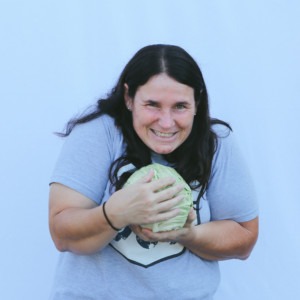This National Truck Driver Appreciation Week, We Salute Our Commercial Drivers
This week is National Truck Driver Appreciation Week! Feeding San Diego’s commercial drivers play a very important role in our organization. They literally get the food out into the community six days a week, arriving at our warehouse in Sorrento Valley before sunrise to load the trucks before taking off for a full day’s worth of stops around San Diego County. Our drivers are tough both mentally and physically, and they have hearts of gold. We spoke to two of our commercial drivers, Denise Lamarr-Bennett and Jim McNelly-Ebisch, to learn more about their journeys at Feeding San Diego (pun intended). Read on to learn more about their paths to becoming a commercial driver, their favorite parts about the job, and what they’re doing when they’re not driving for Feeding San Diego.

Meet Denise Lamar-Bennett
Q: How long have you been a commercial driver?
A: Well, I’ve driven large vehicles/trucks since I was about 15. I just recently got my Class B commercial license to drive heavier weighted trucks.
Q: How long have you been with Feeding San Diego? Why did you choose to work here?
A: I’ve been with Feeding San Diego for about four years. I was laid off from my previous job after 13 years there. I feel it’s important to work at a job you both love and can feel good about. My previous job I worked with animals and conservation. When I saw a commercial driver position was open at Feeding San Diego I had to apply. I knew this was a job where I could do some good, give back to the community, and definitely feel good about.
Q: Tell us about your route. How many sites do you stop at every week? In what cities?
A: About 15-18 stops a week and they are pretty much all over San Diego County: Oceanside, San Marcos, Jamul, Borrego Springs, and Chula Vista just to name a few.
Q: You’re always dropping the food off; do you ever get to stay and see the people receive it?
A: I went on a ride-along with one of our Mobile Pantry trucks. I was only with Feeding San Diego about 4 months at that point and we went to Jacumba. It was very humbling. I was one of the volunteers handing out the apples as people walked up with carts and shopping bags. One man said to me, “Oh, apples! I haven’t had an apple in months.” Definitely a moment I won’t forget.
Q: Why are you working to end hunger?
A: Being hungry affects everything we do. Our mental state, stamina, vision, and our overall body’s health. Next to water, we need food to survive and thrive. Kids shouldn’t go to school hungry and adults shouldn’t wonder where their next meal is coming from because they just paid bills and have no money left for food.
Q: What’s your favorite part about being a commercial driver for Feeding San Diego?
A: Wow! Just one? (LOL!) I’d have to say it’s the camaraderie, the team work. We all have each other’s back to make sure all the food gets delivered. If it means staying a little later or taking on an extra route/delivery we all step up. I work with some of the best driver’s and warehouse crew.
Q: What advice do you have for other women who might be looking into working as a commercial driver?
A: It’s well-known that trucking is a male-dominated industry, but it’s great to see women behind the wheel! I say just go and do it! The field is actually much more open than it used to be and companies want more female drivers.
Q: When you’re not working, where can we find you?
Ha! Well, I’m a bit of a musician so either behind my drum kit or playing guitar.

Meet Jim McNelly-Ebisch
Q: How long have you been a commercial driver?
A: I’ve been a commercial driver since 2006. I had the opportunity to go through a Regional Occupational Program offered by the California Department of Education. You can be trained as a driver, in IT, computer programming, stuff like that. The programs train people at lower socio-economic levels in areas that are sellable on the market. At the time, I was working as a substitute teacher in the Grossmont School District. I’ve had many careers at this point. I was in the Army for two years, and was a student after that. I earned my bachelor’s degree in business administration and master’s in public administration. During my college education I interned at the United Way of San Diego County in their planning division, providing reports for the board’s decision-making services, including what services they would be funding at different agencies. I was also a program auditor for the Summer Food
Service Program that is sponsored by the USDA. Its mission is to feed children that qualified for free meals during the school year and hot meals during the summer. I was a traveling auditor in both Northern and Southern California for four or five years. I’m 72 years old, so I’ve worn a lot of hats. I’ve now been a commercial driver for about 15 years.
Q: Why did you choose truck driving?
A: I was 56 at the time and I had wanted to see America on somebody else’s dime. I wanted to be a nationwide driver from coast to coast. That’s what I got. My first job was out of Tulsa, Oklahoma. I have now visited every state in the lower part of the country.
Q: You’re newer to Feeding San Diego. Why did you choose to work here?
A: My first contact with Feeding San Diego was when I received a flyer about a food distribution at Pechanga Arena. I figured I’d go see what it was about. I was one of, like, 500 people that day. Shortly thereafter I saw an ad for a commercial driver job at Feeding San Diego. Because I had a Class A license, with all the endorsements possible you can have, I put in an application. I can now watch the programs work and see how we put all the food together, put it in a truck, and get it to the sites that provide that same opportunity that I once took advantage of. We have teams of people that solicit the food from different providers and we (the commercial drivers) go out and collect that and prepare it for the different sites.
Q: Tell us about your route. How many sites do you stop at every week? In what cities?
A: I go to the mobile pantries and bring everything the volunteers need to safely and sanitarily handle the food and bag the food. I bring all that to the mobile pantry, plus the food! I go to Campo, Jacumba, Fallbrook, San Marcos, Santa Ysabel, Rincon, Alpine. There’s a lot of them.
Q: You’re always dropping the food off, do you ever get to stay and see the people receive it?
A: Our main goal at Feeding San Diego is to distribute all the food that we bring to the site. We don’t generally have the opportunity to bring food back. The sites get it out there in the community. When I’m there and I see the volunteers need some extra help, physically, I’m there to help them out. It makes my heart feel good to help them help their communities. But I don’t usually get to meet the people who come through, I’m off to the next site at that point.
Q: Why are you working to end hunger?
A: It’s like John F. Kennedy said: “Ask not what your country can do for you, but what you can do for your country.”
Q: What’s your favorite part about being a driver?
A: Watching the volunteers do their job efficiently. That’s my favorite part. Watching them smiling, happy. To them, it’s not a job, it’s something they have chosen to provide to their community. We at Feeding San Diego are doing something wonderful by providing food to our community.
Q: When you’re not driving, what are you likely doing?
A: I work as a chauffeur for a company that offers large party buses. I like doing that. I’m a single person, I have no children, I have never been married. So, when I go home, I have a choice: sitting and looking at the TV or being busy. I like driving people around. On top of that, I also work at AutoZone, and really enjoy working. My genetic grandfather died when he was 96. As long as I can, I’m going to keep doing what I’m doing with Feeding San Diego.








